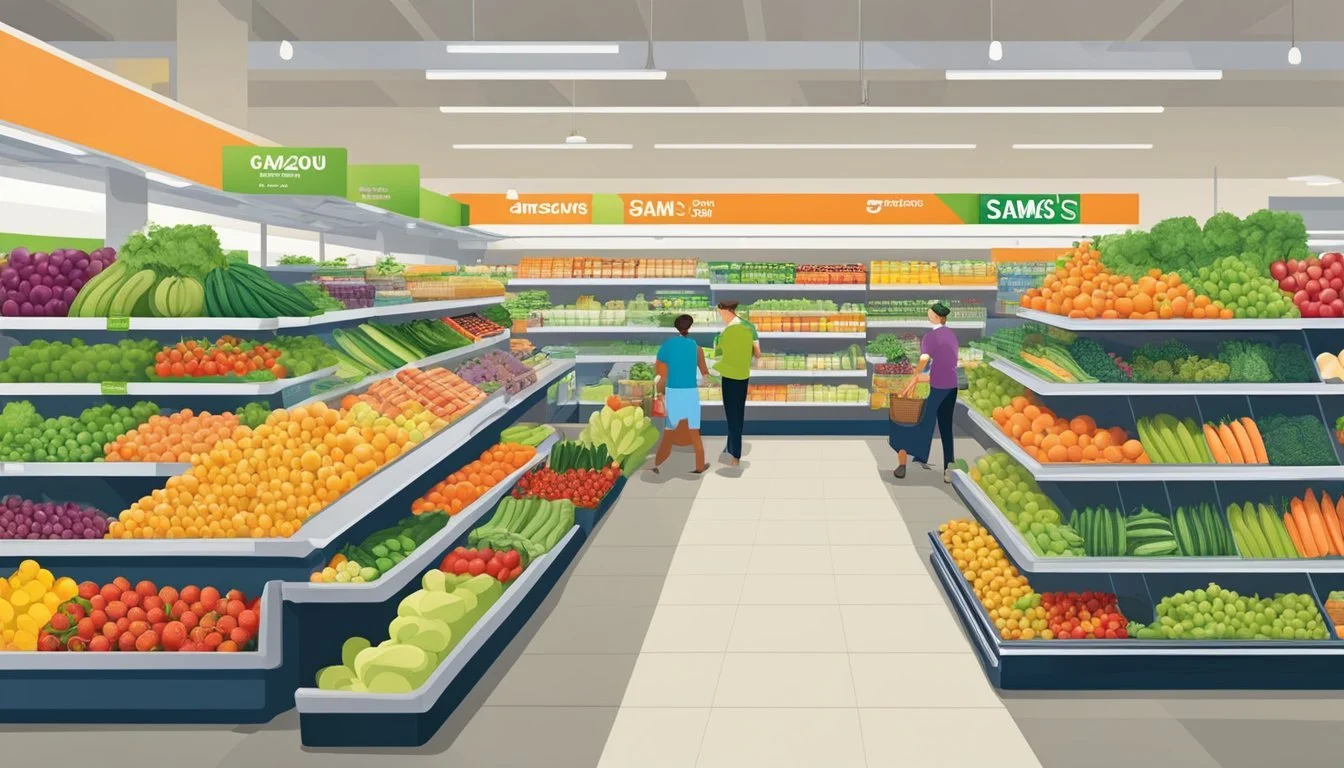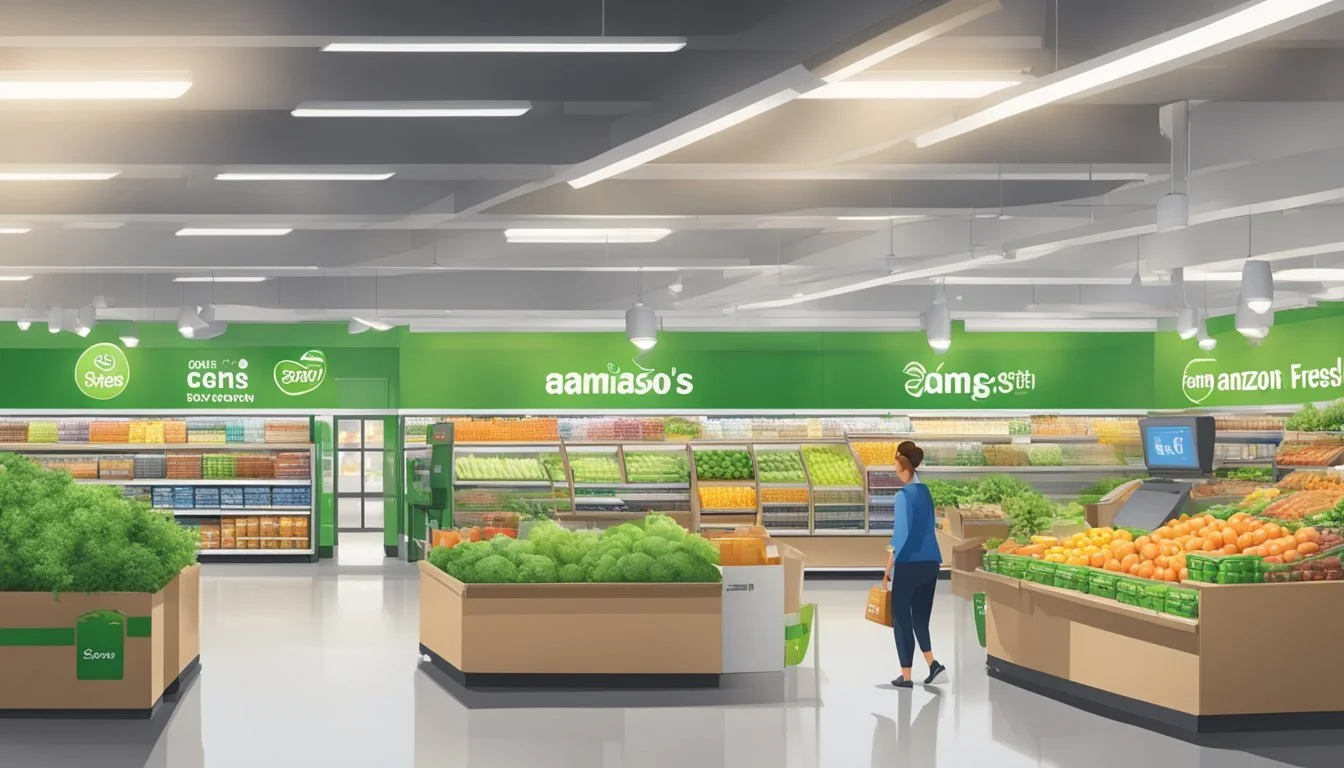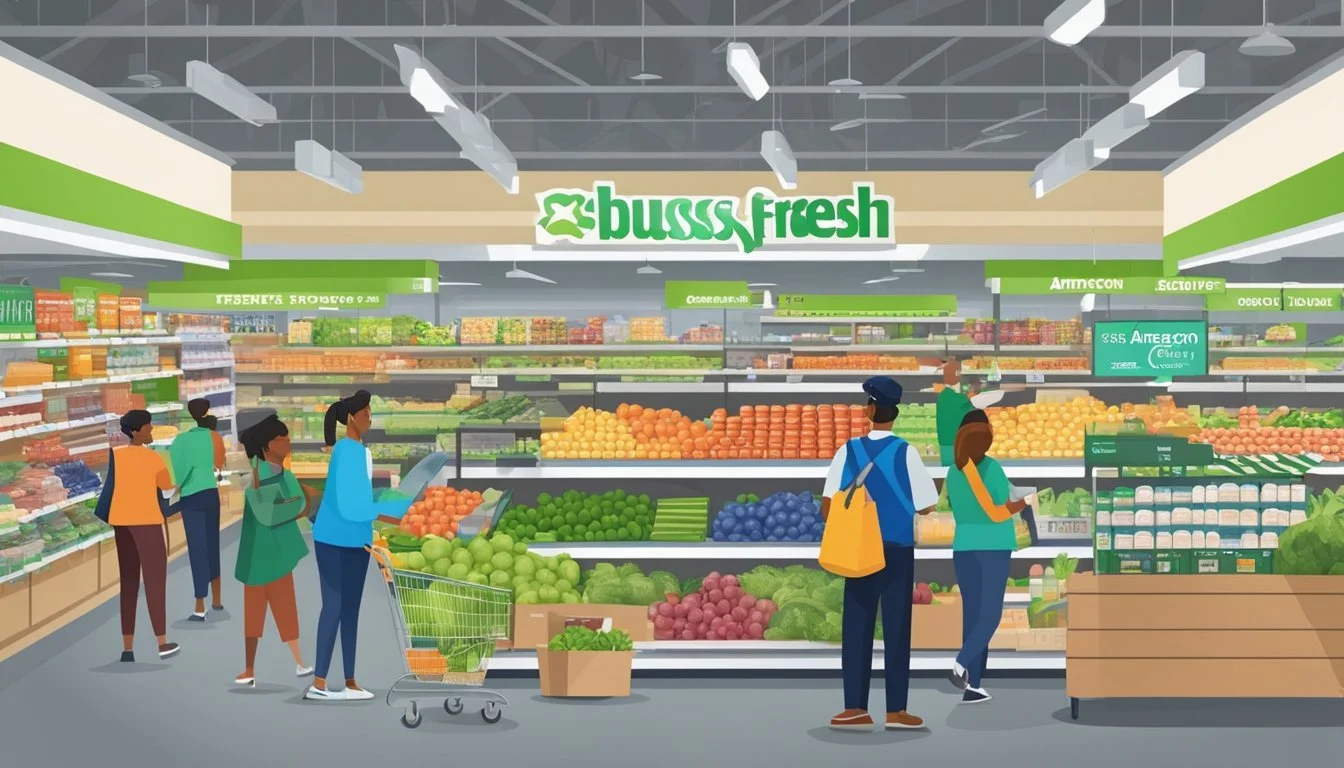Amazon Fresh vs Sam's Club
A Comprehensive Comparison of Price, Quality, and Convenience
Amazon Fresh and Sam's Club represent two distinct approaches to grocery shopping, each with its own advantages. Amazon Fresh offers the convenience of online ordering and home delivery, appealing to tech-savvy consumers who value time-saving solutions. In contrast, Sam's Club provides a warehouse-style shopping experience with bulk purchases and membership perks.
For most shoppers, Amazon Fresh tends to be more expensive overall but offers greater convenience, while Sam's Club generally provides better value for bulk purchases. Amazon Fresh's prices are competitive in some categories, particularly produce, but its Prime membership requirement adds to the total cost. Sam's Club's membership fee can be offset by savings on larger quantities and exclusive discounts.
The choice between these retailers ultimately depends on individual shopping habits and priorities. Families who buy in bulk may find Sam's Club more cost-effective, while those seeking convenience and a wider variety of specialty items might prefer Amazon Fresh. Both stores have their strengths, catering to different consumer needs in the evolving grocery landscape.
Overview of Amazon Fresh and Sam's Club
Amazon Fresh and Sam's Club represent two distinct approaches to grocery retail. Each offers unique advantages for shoppers seeking value and convenience.
History and Business Models
Amazon Fresh launched in 2007 as the e-tail giant's foray into online grocery delivery. It operates as part of Amazon's broader ecosystem, leveraging the company's vast logistics network. Prime members in select areas can access Amazon Fresh's services.
Sam's Club, founded in 1983, is a membership-based warehouse club owned by Walmart. It follows a bulk-buying model, offering discounted prices on large quantities of products. Sam's Club operates physical stores across the United States and has expanded its online presence in recent years.
Range of Products Offered
Amazon Fresh provides a wide selection of groceries, including fresh produce, meat, dairy, and pantry staples. It also offers a variety of Whole Foods Market products, following Amazon's acquisition of the chain in 2017.
Sam's Club stocks an extensive range of products beyond groceries. Members can purchase electronics, furniture, clothing, and more. Its food offerings include bulk packages of non-perishables, fresh produce, meats, and prepared foods.
Online Presence and Grocery Delivery Options
Amazon Fresh offers same-day delivery in many areas, integrated with the Amazon Prime membership. Customers can shop via the Amazon website or mobile app, selecting delivery time slots that fit their schedules.
Sam's Club has enhanced its digital presence, offering online shopping with various fulfillment options. These include curbside pickup, in-club pickup, and home delivery. The company has partnered with Instacart to expand its delivery capabilities.
Membership Advantages
Amazon Fresh is included with Prime membership, which costs $119 annually. Prime members enjoy additional benefits like free shipping on Amazon.com, Prime Video streaming, and exclusive deals.
Sam's Club offers two membership tiers: Club ($45/year) and Plus ($100/year). Both provide access to Sam's Club stores and online shopping. Plus members receive extra perks such as free shipping, early shopping hours, and cash back on qualifying purchases.
Price Comparison and Value for Money
Amazon Fresh and Sam's Club offer distinct pricing strategies and value propositions. Their approaches to everyday essentials, bulk purchases, and membership benefits impact overall costs for shoppers.
General Pricing Strategies
Amazon Fresh focuses on competitive pricing for individual items. They frequently offer discounts and promotions to Prime members. Their prices are generally comparable to standard grocery stores.
Sam's Club employs a bulk-buying model. They sell larger quantities at lower per-unit costs. This approach can lead to significant savings for customers who can store and use larger amounts.
Membership fees differ between the two. Amazon Prime, which includes Fresh access, costs $119 annually. Sam's Club offers a basic membership at $45 per year and a Plus membership at $100.
Comparison of Everyday Essentials
For staple items, Sam's Club often provides better value due to bulk pricing. A 5-pound bag of flour at Sam's Club may cost less per ounce than a 2-pound bag at Amazon Fresh.
Amazon Fresh excels in offering a wider variety of brands and sizes. They frequently price match local competitors for common groceries.
Fresh produce prices can vary. Sam's Club typically offers lower prices on large quantities, while Amazon Fresh may have better deals on smaller portions.
Bulk Purchase Benefits
Sam's Club shines in bulk purchases. They offer significant discounts on large quantities of non-perishable goods, household items, and pantry staples.
Amazon Fresh provides some bulk options but focuses more on standard sizes. They offer "Subscribe & Save" discounts for regular bulk deliveries of certain items.
For families or businesses buying in large quantities, Sam's Club often provides better value. Individual shoppers or those with limited storage may find Amazon Fresh's flexible quantities more suitable.
Quality and Selection of Groceries
Amazon Fresh and Sam's Club offer distinct grocery selections tailored to different shopping preferences. Both stores provide a range of products, from fresh produce to exclusive store brands, catering to various dietary needs and budgets.
Fresh Produce
Amazon Fresh emphasizes convenience with its delivery model, offering a wide variety of fruits and vegetables. Their produce is generally high-quality, sourced from local farms and distributors. Sam's Club, known for bulk purchases, provides larger quantities of produce at competitive prices. While Amazon Fresh may have a broader selection of specialty items, Sam's Club excels in offering family-sized portions of staple fruits and vegetables.
Organic vs. Conventional Options
Both retailers stock organic and conventional groceries. Amazon Fresh, benefiting from its connection to Whole Foods Market, offers an extensive range of organic products across multiple categories. Their 365 by Whole Foods Market line includes many organic options. Sam's Club has expanded its organic offerings in recent years, but the selection is more limited compared to Amazon Fresh. For conventional items, Sam's Club often provides better value due to its bulk-buying model.
Exclusive Store Brands
Amazon Fresh features the 365 by Whole Foods Market brand, known for quality and value in organic and natural products. This line spans various categories, from pantry staples to household items. Sam's Club offers its Member's Mark brand, which covers a wide range of products, often at significant savings compared to national brands. Member's Mark items are typically well-regarded for their quality-to-price ratio, especially in household essentials and packaged foods.
Shopping Experience and Convenience
Amazon Fresh and Sam's Club offer distinct shopping experiences tailored to different customer preferences. Both stores provide unique features that impact convenience, in-store ambiance, and online accessibility.
In-Store Shopping Ambiance
Amazon Fresh stores embrace a modern, tech-focused atmosphere. Shelves are stocked with a mix of everyday essentials and Amazon-branded products. The layout is designed for efficiency, with clearly marked aisles and digital price tags.
Sam's Club warehouses feature a no-frills, bulk-buying environment. Wide aisles accommodate large carts and pallets of merchandise. The store emphasizes value through bulk quantities and displays sample stations for customers to try products.
Both stores offer rotisserie chickens, a popular item for quick meals. Amazon Fresh typically has a dedicated section for fresh produce and prepared foods, while Sam's Club integrates these throughout the warehouse space.
Online Shopping and Navigation
Amazon Fresh's website and app provide a seamless online shopping experience. Users can easily browse products, create lists, and reorder previous purchases. The interface is user-friendly, with personalized recommendations based on shopping history.
Sam's Club's online platform offers a straightforward approach to bulk ordering. Members can shop by department or search for specific items. The website highlights exclusive online deals and allows for easy reordering of frequently purchased products.
Both platforms feature their respective store brands prominently. Amazon showcases its Fresh and 365 by Whole Foods lines, while Sam's Club promotes its Member's Mark products.
Checkout and Payment Processes
Amazon Fresh pioneered "Just Walk Out" technology in select stores, allowing customers to shop and leave without traditional checkout. Shoppers scan a QR code upon entry, grab their items, and exit. The system automatically charges their Amazon account.
Sam's Club offers Scan & Go, where members use their smartphones to scan items as they shop. At checkout, they pay through the app and show a digital receipt to an associate before exiting.
For online orders, Amazon Fresh provides free delivery for Prime members on orders meeting a minimum threshold. Delivery times are often same-day or next-day, depending on location.
Sam's Club offers free delivery on many items for Plus members. Standard members can access delivery for a fee. Delivery times vary but are typically within a few days.
Customer Service and Support
Amazon Fresh and Sam's Club employ distinct approaches to customer service. Both aim to address member needs efficiently, but their methods and policies differ in key areas.
Return Policies and Customer Satisfaction
Amazon Fresh offers a generous return policy. Customers can return most items within 30 days for a full refund. For perishable goods, they provide refunds or replacements if items arrive damaged or spoiled.
Sam's Club allows returns within 90 days for most products. They offer a 100% satisfaction guarantee on their private-label items. Members can return fresh produce if unsatisfied.
Both stores prioritize customer satisfaction. Amazon Fresh leverages its digital platform for quick issue resolution. Sam's Club emphasizes in-store support and personal interactions.
Support Channels and Responsiveness
Amazon Fresh provides 24/7 customer support through phone, email, and live chat. Their digital-first approach enables quick response times. They offer real-time order tracking and proactive communication about delays or issues.
Sam's Club offers support through phone, email, and in-store assistance. Their club locations provide face-to-face problem-solving. Phone support is available during extended business hours.
Amazon Fresh excels in online support, while Sam's Club shines in physical store assistance. Both offer dedicated member support teams to handle complex issues or escalations.
Comparative Analysis of Perishables
Amazon Fresh and Sam's Club both offer a wide range of perishable items. Their selection, quality, and pricing differ in key areas that shoppers should consider when choosing between the two retailers.
Dairy and Egg Quality
Amazon Fresh provides a diverse selection of dairy products and eggs. Their milk options include organic, lactose-free, and plant-based alternatives. Eggs come in various sizes and types, including cage-free and organic varieties.
Sam's Club offers larger quantities of dairy items at competitive prices. Their milk comes in gallon jugs, making it suitable for families. Egg cartons typically contain 36 or more eggs, providing value for bulk buyers.
Both stores maintain proper refrigeration to ensure freshness. Amazon Fresh allows customers to check expiration dates online, while Sam's Club provides this information in-store.
Freshness of Meat and Seafood Selections
Amazon Fresh offers a range of pre-packaged meats and seafood. Their chicken breast options include organic, free-range, and conventionally raised varieties. Seafood selections vary by region and season.
Sam's Club features a larger meat department with both packaged and fresh-cut options. They often have butchers on-site to provide custom cuts. Their seafood selection may be more limited but typically includes popular items like salmon and shrimp.
Both retailers strive to maintain freshness through proper storage and quick turnover. Amazon Fresh delivers items chilled, while Sam's Club allows customers to inspect products before purchase.
Bakery Item Varieties
Amazon Fresh's bakery section includes a mix of artisanal and mass-produced items. They offer various bread types, including whole grain, sourdough, and gluten-free options. Pastries and desserts are also available, with some items sourced from local bakeries.
Sam's Club bakery departments are known for their large-scale production. They offer freshly baked bread, rolls, and pastries daily. Their cakes and pies are popular for events and gatherings due to their size and affordability.
Both stores provide ingredient lists and nutritional information for their bakery items. Amazon Fresh allows customers to filter for dietary preferences, while Sam's Club displays this information on packaging in-store.
Accessibility and Inclusiveness
Amazon Fresh and Sam's Club both strive to provide accessible shopping experiences, though their approaches differ. Each retailer aims to accommodate diverse customer needs and preferences.
Physical Accessibility for Shoppers
Amazon Fresh stores feature wide aisles and clear signage to aid navigation. Their "Just Walk Out" technology eliminates checkout lines, benefiting those with mobility issues. Sam's Club offers motorized carts and wheelchair-accessible checkout lanes. Both retailers provide designated parking spaces for customers with disabilities.
Amazon Fresh's delivery service caters to homebound shoppers. Sam's Club offers curbside pickup, allowing customers to order online and collect groceries without entering the store.
Product Diversity and Cultural Inclusivity
Amazon Fresh stocks a wide range of international foods and specialty items, catering to various dietary preferences and cultural backgrounds. Their selection often includes halal, kosher, and gluten-free options.
Sam's Club focuses on bulk purchases but offers an increasing variety of ethnic foods and specialty products. They partner with diverse suppliers to expand their product range.
Both retailers provide bilingual signage and product information in some locations. Amazon Fresh's app offers multiple language options, while Sam's Club's website can be viewed in Spanish.
Additional Services and Features
Amazon Fresh and Sam's Club offer more than just groceries. Both provide diverse product selections and innovative shopping experiences to enhance convenience for customers.
Non-Grocery Items and Extended Merchandise
Amazon Fresh expands beyond food with household essentials, electronics, and personal care items. Customers can add books, small appliances, and pet supplies to their grocery orders.
Sam's Club boasts a wider range of non-grocery products. Members find furniture, clothing, jewelry, and even tires. The store's bulk offerings extend to office supplies, outdoor equipment, and electronics.
Both retailers sell their own private label brands alongside national names. Amazon offers items from its AmazonBasics line, while Sam's Club features Member's Mark products.
Multichannel Shopping Experience
Amazon Fresh integrates with other Amazon services. Prime members enjoy free grocery delivery and can combine orders with regular Amazon purchases.
The platform links to Amazon's video streaming and music services. Customers can add entertainment subscriptions or digital content to their grocery carts.
Sam's Club provides a mobile app for easy ordering and in-store scanning. Members can use Scan & Go for a quicker checkout process.
The retailer partners with Instacart in some areas, offering same-day delivery options. Sam's Club also provides curbside pickup for added convenience.
Environmental Considerations and Sustainability Efforts
Amazon Fresh and Sam's Club have implemented various eco-friendly initiatives to reduce their environmental impact. These efforts focus on packaging, waste reduction, and sustainable supply chain practices.
Eco-Friendly Packaging and Waste Reduction
Amazon Fresh has made significant strides in reducing single-use plastic. In 2022, the company decreased plastic usage by 11.6% across its global operations. They achieved this by expanding paper-based packaging options and using lighter, more flexible materials.
Amazon has also eliminated packaging entirely for some items. In 2022, 11% of all packages shipped globally were delivered without added Amazon packaging. This reduction in packaging materials helps minimize waste and environmental impact.
Sam's Club, in partnership with Walmart, has introduced new food waste management systems. These technologies aim to reduce food waste in their stores and distribution centers, contributing to overall sustainability efforts.
Sustainable Supply Chain Practices
Sam's Club, through its parent company Walmart, has launched initiatives to promote sustainable practices throughout its supply chain. One example is the Tide Collab for Cold campaign, which encourages customers to wash clothes in cold water.
This initiative promises to keep clothes looking bright while helping people save money and reduce energy use. Washing in cold water can save approximately 90% of the energy used in an average laundry load.
Walmart, which includes Sam's Club, is also working to decarbonize its value chain. This effort is crucial, as Scope 3 emissions account for up to 98% of the retail industry's total emissions. By focusing on these areas, Sam's Club aims to make a significant impact on reducing its overall carbon footprint.
Conclusion and Final Verdict
Amazon Fresh and Sam's Club cater to different shopping needs and preferences. Amazon Fresh offers convenience with its online ordering and delivery service, making it ideal for busy individuals or those who prefer shopping from home.
Sam's Club excels in bulk purchases and competitive pricing on many items. Its membership model can provide significant savings for families or businesses buying in large quantities.
Product selection varies between the two. Amazon Fresh typically offers a wider range of everyday grocery items and specialty products. Sam's Club focuses more on bulk options and exclusive member deals.
Both stores have strengths in certain departments. Amazon Fresh often has competitive prices on produce and packaged goods. Sam's Club generally offers better deals on meat, particularly when buying larger quantities.
The choice between Amazon Fresh and Sam's Club ultimately depends on individual shopping habits, household size, and priorities. Those valuing convenience and a broad selection may prefer Amazon Fresh. Shoppers looking to save on bulk purchases might find Sam's Club more suitable.
Neither option is universally superior. Each store has its unique advantages, making them complementary rather than direct competitors in many ways.









